5 Reasons Why Short-Term Municipal Bonds Make Sense Now
Last week Federal Reserve Chairwoman Janet Yellen insisted that record-low interest rates will stay as they are for a “considerable time.” So what does that mean for bond investors? Many people realize that rising interest rates affect yields and prices, but what others might not know is that if you stick closely to short-term, investment-grade debt securities—the very kind our Near-Term Tax Free Fund (NEARX) invests in—the impact of such a rate hike is not as dramatic as some investors might think.
As you can see in the chart below, NEARX has been a steady grower over the years, in times of rising and falling interest rates as well as extreme market downturns. In fact, it’s taken nearly a decade and a half for the S&P 500 Index to surpass NEARX using a hypothetical $100,000 investment back in June 2000.
Think of NEARX, then, as the emotionally-stable, no-drama fund.
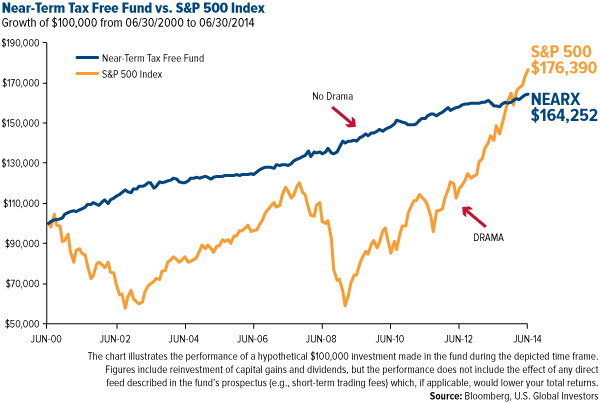
Take a look at the latest performance of the fund here.
Although short-term bonds might not be as sexy as common stocks in fashionable brands like Apple and Tesla, they play an important role in any serious investor’s portfolio. Below are five reasons why investing in municipal bonds makes sense now more than ever.
1. Short-term, investment-grade municipal bonds are less volatile in a climate of rising interest rates.
Interest rates are currently at 50-year lows, but as I wrote about previously, they can’t stay near zero forever. And when rates do rise, bond prices will fall. At first glance, this inverse relationship might seem illogical, but it makes sense. If newly issued bonds carry a higher yield, the value of existing bonds with lower rates fall.
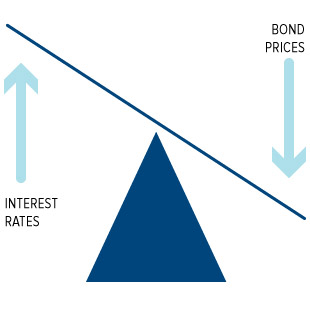
Let’s imagine the Fed raised rates tomorrow. What potential implications would that have on the yield curve and bond prices? As you can see in this hypothetical example using a two-year, 10-year and 30-year Treasury, the farther out the maturity date and higher the rate hike, the more your security would be affected. Remember, these are Treasuries, not municipal bonds, but munis could be similarly affected.
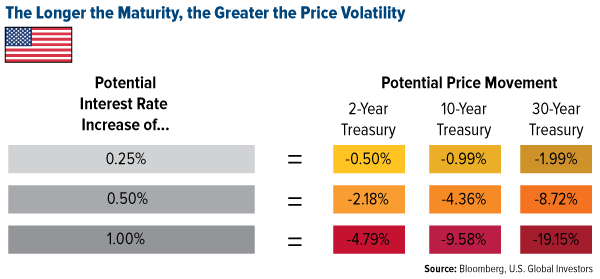
As you might guess, what this indicates is that investors should take advantage of short-term bonds, which are less sensitive to rate increases than longer-term bonds that are locked into rates for greater periods of time.
I want to reassure investors that when the Fed raises rates next year, as many economists and analysts speculate, it will most likely be done incrementally over the course of several months rather than in one fell swoop. Just as deep sea divers risk getting the bends when they surface too fast, there’s economic risk in allowing rates to rise too much too quickly. The Fed is well aware of this.
Below is one research firm’s projection of what rates might look like at different time periods in the future. As you can see, the probability of higher rates rises gradually over time. Some readers might perceive this forecast as too dovish, but it makes the point that an unexpectedly huge rate hike that some investors fear is unlikely.
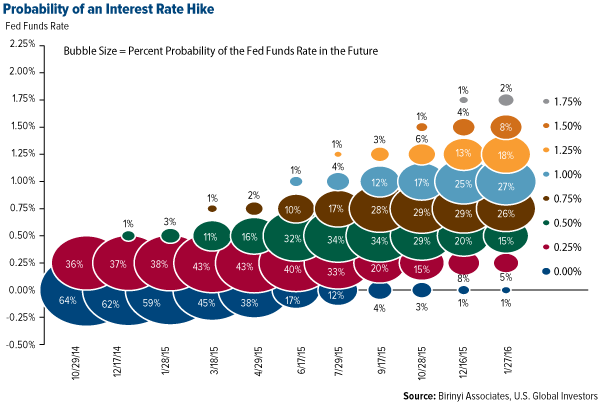
What the chart also shows is that there’s still time to gain exposure to short-term securities, which are less sensitive to interest rate hikes. NEARX not only invests in such securities but is actively managed by professionals who closely monitor the bond market and interest rate environment.
John Derrick, Director of Research at U.S. Global Investors and portfolio manager of the Near-Term Tax Free Fund, stated during his recent interview with Oxford Club Radio that rising interest rates can actually work in the fund’s favor: “When interest rates rise, we’ll try to step in and use that volatility to our advantage. You just try to be prudent about how you position duration and maturity structure.”
2. Investment-grade munis have a low default risk.
In 2013, your chances of investing in a reliable, secure municipal bond from an issuer that wouldn’t default were roughly 99.9 percent. That’s according to the number of bond issues in the S&P Municipal Bond Index that defaulted last year. Out of more than 21,000 bonds in the index, only 23 failed to meet their payment obligations.
In the table below, you can see there’s a greater likelihood that an issuer won’t default the higher its rating and the shorter its maturity. Bottom line: these securities are relatively safe.
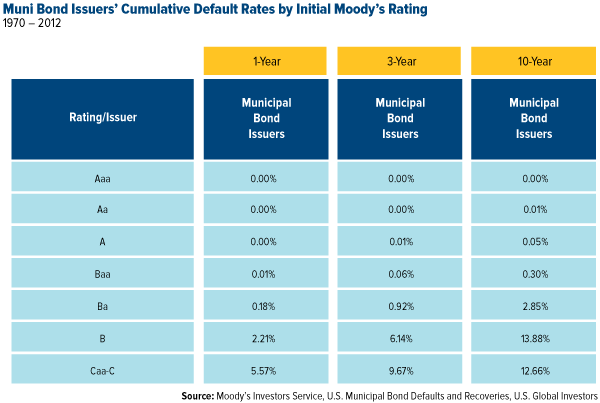
In a July Frank Talk, John held that:
“On a tax-adjusted basis, municipal bonds have a very compelling risk-reward profile, which means the risk-adjusted returns are high. To take advantage of this, I would encourage investors to add exposure to their portfolio by investing in a product that holds high-quality, traditional municipal bonds.”
John reiterated this point during his interview with Oxford Club Radio: “At the end of the day, we stick to the high-quality munis. We really don’t play in the higher yield front, where there’s more of a risk of a correction.”
3. Municipal bonds are tax-free at the federal level.
As you might already know, munis are typically exempt from federal income taxes and often from state and local income taxation as well. This fact is especially appealing to high net worth individuals who want to minimize the tax impact on their investments.
That means more money stays in your pocket and can be reinvested.
4. Munis help diversify your portfolio.
 It’s prudent to have a diversified portfolio of both equity and debt securities, not to mention cash and commodities such as gold. Stocks can offer you growth and capital gains while bonds provide income and can help protect your assets during more volatile times.
It’s prudent to have a diversified portfolio of both equity and debt securities, not to mention cash and commodities such as gold. Stocks can offer you growth and capital gains while bonds provide income and can help protect your assets during more volatile times.
Even within the bond portion of your portfolio, it’s important to diversify the types of debt securities you’re investing in. NEARX, for instance, holds a wide range of municipal bonds, from school districts to transportation to utilities.
“We’re buying high-quality municipals, GOs [general obligations] and essential service revenue,” John says.
He likes to describe NEARX as a “classic municipal bond fund.”
“We operate in a very conservative manner, probably much more so than most of our peers. It’s not the kind of fund where you’re going to wake up one day and find that some high-yield security has blown up.”
5. Municipal bonds help make America strong.
Speaking of schools, transportation, utilities and other projects, bonds help state and local governments build, repair and maintain much-needed services. This is one of the most compelling reasons to invest in short-term, investment-grade munis. Not only do they have an attractive risk-reward profile and offer tax-free income, they also ensure that municipalities have the funding to provide their citizens with essential needs like education, roads and energy and help build their communities.
Below you can see what some of the largest bond issuances are earmarked for. Without exception, the revenue that bonds generate goes toward services that make America’s states, counties and cities attractive places to live.
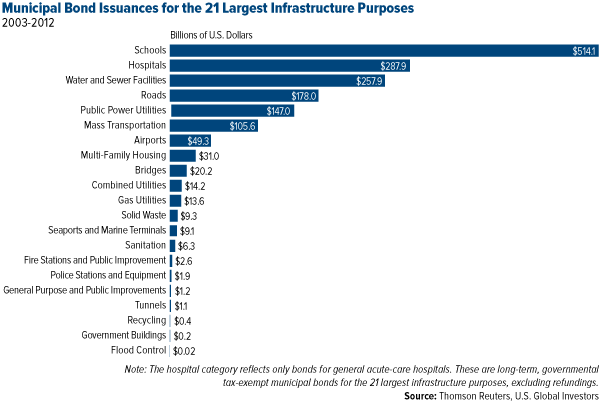
Also, there’s reason to believe that issuing bonds is the most effective way for governments to generate the funding necessary for specific undertakings. In a recent POLITICO Magazine article entitled “Are Conservative Cities Better?”, columnist Ethan Epstein shows that whereas some cities and municipalities rely on and raise taxes indefinitely to fund projects and programs, others prefer instead to issue bonds because they’re intended for only one sole purpose:
“[B]ond issues go to specific projects, and cover only a specific amount of money. That’s different from funding a social program, or simply forking over higher taxes and hoping that the extra funds go where the government says they’re going.”
“People are OK with investing in their communities,” says former Mesa, Arizona, mayor Scott Smith, adding, “People don’t trust programs. They trust… tangible results.”
However one feels about social programs, Mayor Smith’s point is clear: bonds do precisely what they’re designed to do, namely, fund projects such as hospitals and roads that benefit all citizens, young and old, rich and poor.
Take a Look at NEARX.
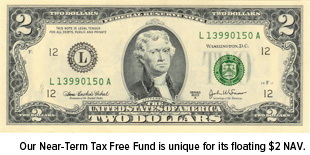 The Near-Term Tax Free Fund recently received the coveted five-star rating from Morningstar* for the three-year performance period in the Municipal National Short-Term category, and it’s been rated four stars overall for many years. The turnover of NEARX is very low, and it has performed well against its peers. Additionally, the fund seeks preservation of capital and has a floating $2 net asset value (NAV) that has demonstrated minimal fluctuation in its share price.
The Near-Term Tax Free Fund recently received the coveted five-star rating from Morningstar* for the three-year performance period in the Municipal National Short-Term category, and it’s been rated four stars overall for many years. The turnover of NEARX is very low, and it has performed well against its peers. Additionally, the fund seeks preservation of capital and has a floating $2 net asset value (NAV) that has demonstrated minimal fluctuation in its share price.
For those investors who wish to seek tax-free income and portfolio diversity and who want to take an active role in strengthening America’s infrastructure, I encourage you to request an information packet.
Remember to sign up for our October 2 webcast, “One World Market, Many Central Banks: How Will Your Investments Be Impacted?” Participants can receive a continuing education (CE) credit. Also, be sure to download my latest whitepaper, “Managing Expectations: Anticipate Before You Participate in the Market.”
Stay curious!
Please consider carefully a fund’s investment objectives, risks, charges and expenses. For this and other important information, obtain a fund prospectus by visiting www.usfunds.com or by calling 1-800-US-FUNDS (1-800-873-8637). Read it carefully before investing. Distributed by U.S. Global Brokerage, Inc.
*Morningstar ratings based on risk-adjusted return and number of funds
Category: Municipal National Short-Term Funds
Through: 08/31/2014
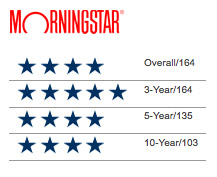
Tax-exempt income is federal income tax free. A portion of this income may be subject to state and local income taxes, and if applicable, may subject certain investors to the Alternative Minimum Tax as well. The Near-Term Tax Free Fund may invest up to 20% of its assets in securities that pay taxable interest. Income or fund distributions attributable to capital gains are usually subject to both state and federal income taxes. The Near-Term Tax Free Fund may be exposed to risks related to a concentration of investments in a particular state or geographic area. These investments present risks resulting from changes in economic conditions of the region or issuer. Bond funds are subject to interest-rate risk; their value declines as interest rates rise.
The S&P 500 Stock Index is a widely recognized capitalization-weighted index of 500 common stock prices in U.S. companies. The S&P Municipal Bond Index is a broad, market value-weighted index that seeks to measure the performance of the U.S. municipal bond market.
Fund portfolios are actively managed, and holdings may change daily. Holdings are reported as of the most recent quarter-end. Holdings in the Near-Term Tax Free Fund as a percentage of net assets as of 6/30/2014: Apple 0.00%, Tesla 0.00%.
Morningstar Ratings are based on risk-adjusted return. The Morningstar Rating for a fund is derived from a weighted-average of the performance figures associated with its three-, five- and ten-year Morningstar Rating metrics. Past performance does not guarantee future results. For each fund with at least a three-year history, Morningstar calculates a Morningstar Rating based on a Morningstar Risk-Adjusted Return measure that accounts for variation in a fund’s monthly performance (including the effects of sales charges, loads, and redemption fees), placing more emphasis on downward variations and rewarding consistent performance. The top 10% of funds in each category receive 5 stars, the next 22.5% receive 4 stars, the next 35% receive 3 stars, the next 22.5% receive 2 stars and the bottom 10% receive 1 star. (Each share class is counted as a fraction of one fund within this scale and rated separately, which may cause slight variations in the distribution percentages.)
All opinions expressed and data provided are subject to change without notice. Some of these opinions may not be appropriate to every investor. By clicking the link(s) above, you will be directed to a third-party website(s). U.S. Global Investors does not endorse all information supplied by this/these website(s) and is not responsible for its/their content.
Past performance does not guarantee future results. Diversification does not protect an investor from market risks and does not assure a profit.
********
All opinions expressed and data provided are subject to change without notice. Some of these opinions may not be appropriate to every investor. Fund portfolios are actively managed, and holdings may change daily. Fund portfolios are actively managed, and holdings may change daily. Holdings are reported as of the most recent quarter-end.






 Frank Holmes is the CEO and Chief Investment Officer of U.S. Global Investors. Mr. Holmes purchased a controlling interest in U.S. Global Investors in 1989 and became the firm’s chief investment officer in 1999. Under his guidance, the company’s funds have received numerous awards and honors including more than two dozen Lipper Fund Awards and certificates. In 2006, Mr. Holmes was selected mining fund manager of the year by the Mining Journal. He is also the co-author of “The Goldwatcher: Demystifying Gold Investing.” Mr. Holmes is engaged in a number of international philanthropies. He is a member of the President’s Circle and on the investment committee of the International Crisis Group, which works to resolve conflict around the world. He is also an advisor to the William J. Clinton Foundation on sustainable development in countries with resource-based economies. Mr. Holmes is a native of Toronto and is a graduate of the University of Western Ontario with a bachelor’s degree in economics. He is a former president and chairman of the Toronto Society of the Investment Dealers Association. Mr. Holmes is a much-sought-after keynote speaker at national and international investment conferences. He is also a regular commentator on the financial television networks CNBC, Bloomberg and Fox Business, and has been profiled by Fortune, Barron’s, The Financial Times and other publications. Visit the U.S. Global Investors website at
Frank Holmes is the CEO and Chief Investment Officer of U.S. Global Investors. Mr. Holmes purchased a controlling interest in U.S. Global Investors in 1989 and became the firm’s chief investment officer in 1999. Under his guidance, the company’s funds have received numerous awards and honors including more than two dozen Lipper Fund Awards and certificates. In 2006, Mr. Holmes was selected mining fund manager of the year by the Mining Journal. He is also the co-author of “The Goldwatcher: Demystifying Gold Investing.” Mr. Holmes is engaged in a number of international philanthropies. He is a member of the President’s Circle and on the investment committee of the International Crisis Group, which works to resolve conflict around the world. He is also an advisor to the William J. Clinton Foundation on sustainable development in countries with resource-based economies. Mr. Holmes is a native of Toronto and is a graduate of the University of Western Ontario with a bachelor’s degree in economics. He is a former president and chairman of the Toronto Society of the Investment Dealers Association. Mr. Holmes is a much-sought-after keynote speaker at national and international investment conferences. He is also a regular commentator on the financial television networks CNBC, Bloomberg and Fox Business, and has been profiled by Fortune, Barron’s, The Financial Times and other publications. Visit the U.S. Global Investors website at 










